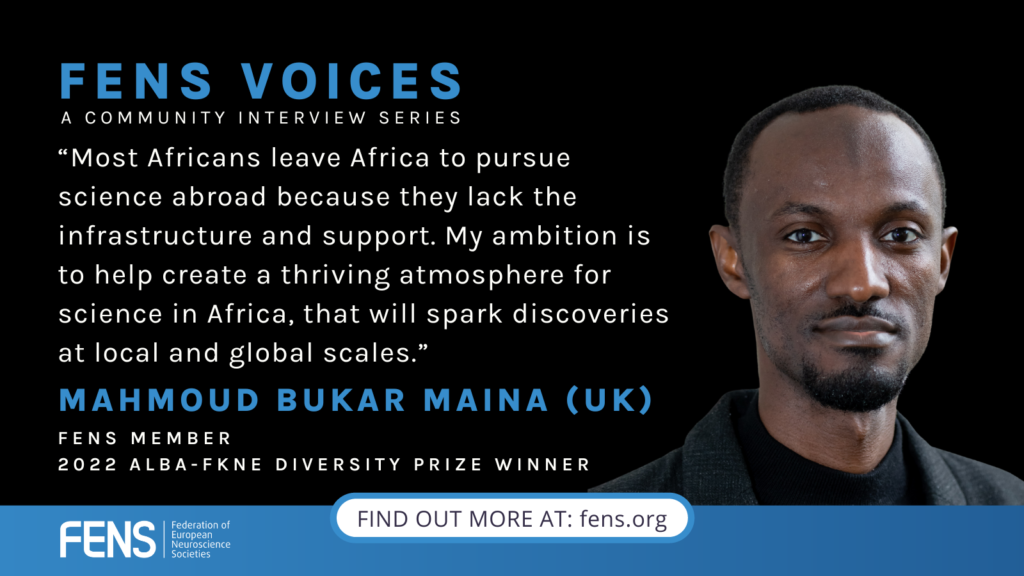
FENS Voices | Mahmoud Bukar Maina: Neuroscience for all
20 December 2022
FENS News, Neuroscience News
FENS talked this week to Dr Mahmoud Bukar Maina, a FENS member who is passionate about inspiring and training the next generation of scientists, while also enhancing the overall public understanding of science. Dr Maina is the Alzheimer’s Association Research Fellow at the University of Sussex Neuroscience (UK), and early career Team Leader at the Biomedical Science Research and Training Centre (BioRTC) at Yobe State University, Nigeria. He has founded many outreach initiatives, including the TReND Outreach Programme, Science Communication Hub Nigeria and the African Science Literacy Network. His interest in supporting the development of neuroscience within Africa earned him the 2022 ALBA-FKNE Diversity Prize.
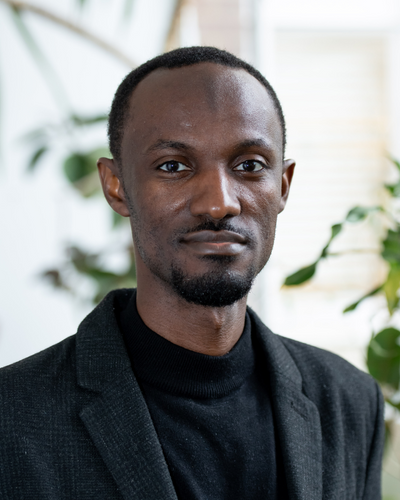
What initially attracted you to science? How did you develop an interest in neuroscience?
MBM: I got attracted to science thanks to my dad, who was at that time a secondary school teacher. My dad had a book called Simple Science Experiments (by Hans Jurgen Press), which had many simple experiments that one could try doing with readily available materials at home. I used to do these experiments with my siblings, especially electronics experiments. Those moments gave me the biggest inspiration to pursue a neuroscience career.
How was it to study Human Anatomy?
MBM: I had dreams of becoming a doctor from a young age and my parents also wanted me to study Medicine, sharing their desire with me. As a result, I was called “doctor” ever since I was little. However, unlike many institutions worldwide, in most Nigerian public institutions, one is not guaranteed to pursue the domain of their choice even with the necessary qualifications/scores. For this reason, I was not admitted to study Medicine for my undergraduate degree. Instead, I was admitted to study Human Anatomy. Not getting into my course of choice demoralised me at first. In fact, I performed average during the first two years of my Human Anatomy degree because I was busy trying to find fellowships to study abroad. It was during the third year that I fully focused my attention on my studies, realising that my scholarship hunt would not pay off. I scored extremely high in my third and fourth years, which enabled me to graduate with a second-class upper division, despite my average performance in the first two years. However, I am thankful for the Human Anatomy degree period, as it brought me the researching career of today. Had I pursued Medicine, it might have been a different story, as very little emphasis is given on research in the Medicine curricula within Nigerian institutions.
Looking back now, I realise how challenging it was to study. The training provided us with in-depth theoretical background, but with little hands-on experience in modern research techniques. Most of the time, we read things about research, but we don’t get to practice in the context of a laboratory. For example, during my undergraduate degree I didn’t get to see how common techniques like Western blots were set up. We were shown an electron microscope during one of the practical sessions, but the microscope stopped working long before I got admitted to the school. Most Africans have a similar experience, due to inadequate laboratory infrastructure in institutions across the continent.
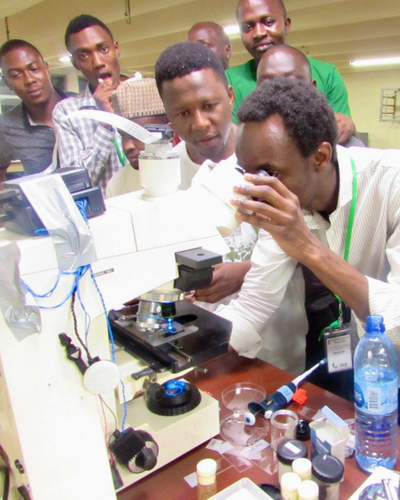 In 2011, you joined the University of Sussex for your Master of Science in Cellular and Molecular Neuroscience and you graduated with the top distinction in your class. Was studying in the UK any different from studying in Nigeria? What were your greatest challenges, if any?
In 2011, you joined the University of Sussex for your Master of Science in Cellular and Molecular Neuroscience and you graduated with the top distinction in your class. Was studying in the UK any different from studying in Nigeria? What were your greatest challenges, if any?
MBM: Studying in the UK was much different than studying in Nigeria. For example, in Nigeria you would often get the impression that some of your lecturers want you to fail. There was little encouragement from their side. Instead, many often bullied students and unfortunately, the students were often scared to complain, in order to avoid being the victims of these lecturers during exam period. Moreover, oftentimes, students felt scared to pose questions to their professors during classes because some lecturers didn’t like it. Although things are changing, this was mostly the situation during my days. In England I found the complete opposite. Lecturers were keen to hear your questions and to offer answers; they were prepared to support you and to help you succeed. Moreover, the differences regarding the educational facilities between England and Nigeria were immense. However, this also meant additional work for me. I realised that most of my classmates from the UK found it easier to navigate through their studies because they had a good background in the UK educational system, while I didn’t. As a result, I always had to read more. I also made more errors in the lab, since it was practically the first time I got to learn about most of the techniques. Nonetheless, the spirit of resilience we were forced to adopt in Nigeria enabled me to succeed and finish with the top distinction from my MSc class.
If you would be talking to a younger Mahmoud, what advice would you give him?
MBM: Seek mentors early on. It took me a long time to realise I didn’t want to study medicine and that my passion was research. Had I had a mentor, it would have been easier for me to discover this early on. Unfortunately, there were not many visible mentors during my days, and even now, science role models are scarce where I come from. As a result of the deeply colonised curriculum in our schools, we often think successful scientists are white men.
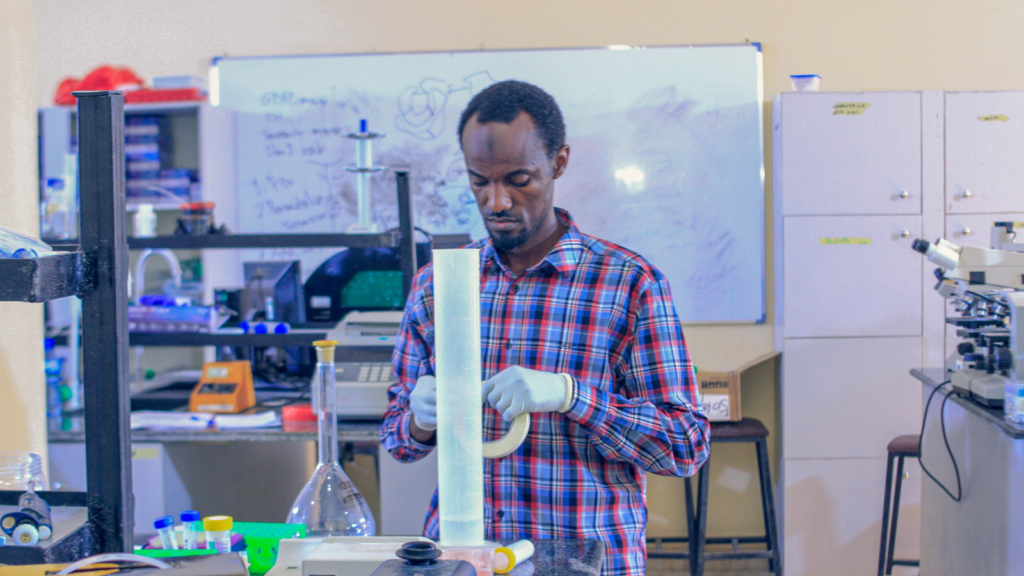 You continued your academic career following a PhD in the Serpell laboratory of University of Sussex. Why did you pursue a doctoral degree in neuroscience?
You continued your academic career following a PhD in the Serpell laboratory of University of Sussex. Why did you pursue a doctoral degree in neuroscience?
MBM: While growing up, there were a lot of misconceptions about brain diseases within my community. People often ascribed mental illness to witchcraft. I remember as a kid, when we saw people suffering from mental illnesses, we were scared of them. Later during my undergraduate degree, I realised that disturbances in the brain are the cause of most brain diseases. This led me to develop an interest in neuroscience, and not just contribute to discoveries about treating brain diseases through my research, but also to enhance public understanding of these diseases and dispel misconceptions about them. Later, I worked at the Federal Neuropsychiatric Hospital in Maiduguri, Nigeria, which consolidated my interest in neuroscience. However, in Nigeria and in many African countries, Neuroscience as a course doesn’t exist. This is why I left Nigeria in order to pursue my MSc in Cellular and Molecular Neuroscience and later my PhD in Neuroscience in the UK.
Your PhD focused on the role of nuclear Tau in Alzheimer’s disease. Why did you choose this topic?
MBM: I joined the lab of Prof. Louise Serpell for my MSc Project. During that time, a part of the lab work was investigating the distribution of Tau in the nucleus following the administration of amyloid beta to neuronal cells. Tau was originally discovered as a microtubule-binding protein, so it was not expected to be found in the nucleus of neuronal cells. I became interested in the project because I thought it would enable me to investigate the connection between amyloid beta and Tau, both of which aggregate and form the classical hallmarks of Alzheimer’s disease. As I was reading the required literature, I realised that Tau is found in many cellular compartments, such as the nucleus and it is also involved in many other brain diseases that are collectively called tauopathies, which include Alzheimer’s disease, frontotemporal dementia, Pick’s disease etc. However, I also realised that researchers in the field focus more on the role of Tau in microtubules or its aggregation and toxicity. Understanding Tau’s other roles have the potential to change our views on its involvement in the development/progression of tauopathies and can influence the development of effective drugs to treat these diseases. That was how my interest in this area started. To understand the role of Tau in the nucleus, I pursued my PhD on the same topic, during which I invested a lot of time in developing different imaging and biochemistry protocols and established collaboration with Groups in Sussex Genome Damage and Stability Centre. This enabled me to investigate the role of Tau in the nucleolus using multidimensional approaches. My studies were foundational in showing, for the first time, that Tau localises with the nucleolar remodelling complex in cell models and the human brain. Accordingly, I went on to show that the loss of Tau results in altered nucleolar transcription, leading me to hypothesise that Tau loss of function could be a critical pathogenic mechanism in AD. Although there is still much to be discovered about Tau’s function in the nucleus and nucleolus, my work raises questions on how Tau contributes to pathology in disease and how Tau-targeting drugs can be effectively developed.
What were the greatest challenges of being a PhD student and how did you manage to overcome them?
MBM: Different people would face different challenges during their PhD. Although, many of these would be similar, e.g. stress, loss of motivation etc. My biggest challenge was that I was the only person in our group investigating the direction of my research on the role of Tau in the nucleus. So, I kind of felt isolated, and it wasn’t easy to find my direction at first, since our group’s expertise was a bit focused towards Tau aggregation. However, I was very lucky to have a very supportive supervisor, who allowed me to try new things despite many failed experiments and build my own collaboration. Ultimately, I overcame the feeling of being isolated by establishing a collaboration with experts at the University of Sussex Genome Damage and Stability Centre, which helped me find guidance in the DNA-binding aspect of my work.
When you are not busy in the laboratory, you are promoting and communicating science, organising and participating in science communication activities in Africa and the UK. You founded the TReND in Africa Outreach Programme and you also founded Science Communication Hub Nigeria, in order to enhance students’ access to science role models, while also offering public access to accurate science. One man and so many honourable activities. What does your typical day look like?
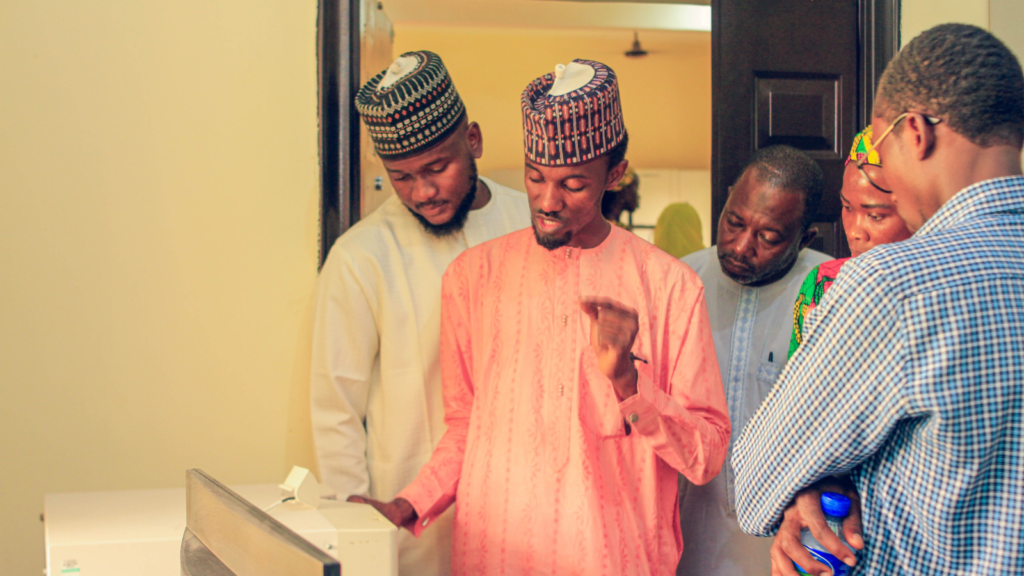
MBM: My typical day starts around 6 AM and ends just before midnight. I start with morning prayers, then I take the kids to school and afterwards I go to the lab. As with many scientists, I do experiments, I have meetings and other engagements during the day. However, many times during the week, I do extra things related to science in Africa. Initially, it was really hard when I started these different projects in my home country. On several occasions, I used my holiday to run my science communication activities. I guess one reason why I succeeded, despite the stress of doing many things, was the fact that I enjoyed doing activities that aligned very well with my passion. As everything became more stable, the work got a bit easier. I am lucky to have a supportive family, good mentors and a fantastic team to support me. Thanks to a wonderful team, I am not forced to do everything myself, allowing me to have more control over my time.
Thanks to your efforts and to sponsors, the Biomedical Science Research and Training Centre (BioRTC) was launched in Yobe State University, meant to serve as a core facility for research and training of African neuroscientists using state-of-the-art laboratory infrastructure. You helped launch Science Communication Hub Nigeria, in order to enhance students’ access to science role models and to offer public access to accurate science. It is clear that you put so much effort in supporting the African science community. What drives you?
MBM: I am driven by the passion of helping create an environment where African scientists can do great science within Africa, close to their families and communities. When I first came to England for my MSc, I was inspired by how I saw science being done. Here, equipment is available for researchers and scientists, who passionately live and breathe their science. The public also supports scientists with words of encouragement and some even donate funds for research through charities. The atmosphere is just good and supports science to thrive. Although I am aware that the situation here is also deteriorating, it is not happening at such a fast pace as it does in Africa. Most Africans leave Africa to pursue science abroad because they lack the infrastructure and support at home. Within Europe, for example, scientists often move to gain experience, not because of the lack of infrastructure in their home countries. My ambition is to help create a thriving atmosphere for science in Africa. This will spark discoveries at local and global scales.
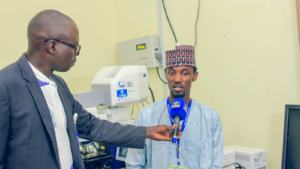 You are already an accomplished researcher. How would you describe your first research project?
You are already an accomplished researcher. How would you describe your first research project?
MBM: My undergraduate project was my first introduction to research. Unlike in the UK, where students join a lab to execute an ongoing project, in most Nigerian Universities, students are expected to come up with their research project. I was lucky to work under the mentorship of Prof. Sani H. Garba, whose work focuses on the toxicology of local herbs in rodents. During that time, there was a popular Chinese tea that people in my community widely consumed because of its acclaimed health benefits. I used the United States Environmental Protection Agency’s Guidelines for Repeated Dose 28-Day Oral Toxicity Study in Rodents to investigate whether long-time consumption of the tea was toxic to rats. This revealed that when taken for a long term, especially at a high dose, the tea can result in toxicity to several organs of the rat. Although I used very basic histology techniques, the work sparked my interest for research. The work led to my first scientific publication in the Journal of Pharmacology and Toxicology.
Who are your role models in science and why?
MBM: I have been inspired by so many people, some of which are not coming from my field of research. For example, I have been a big fan of Albert Einstein for his discoveries. During my undergraduate degree, we even had a group called “Energy Group”, and our group slogan was “E=MC2”. However, my biggest inspiration became Prof. Isa Hussaini Marte, when we met in 2012. Prof. Marte is a Nigerian scientist, formally a Group Leader and Associate Professor at the University of Virginia, United States. In 2010 he moved to Nigeria to lead his research. His motivation to move back to Nigeria was out of a passion for helping train the next generation of scientists in our home country. He truly serves as an inspiration to me and to many African scientists, since he was highly successful as a scientist in the United States in Glioblastoma research. He had no reason to return, given the inadequate infrastructure and support for science in Nigeria compared to the United States. Nonetheless, he returned out of his passion to help develop high-level research at home. His action was a true sacrifice. Additionally, it is important for underrepresented scientists to identify role models within their niches, as that will make them believe they can do it too.
You are the recipient of numerous awards. Recently you won the ALBA-FKNE Diversity Prize. How has it impacted your career? How important are these types of grants and awards for researchers?
 MBM: It was a huge honour to be awarded the ALBA-FKNE Diversity Prize. Often times, scientists, especially those from underrepresented backgrounds, have this impostor syndrome. Awards like this help them feel more confident in their work. Moreover, it increases their visibility, which is critical for their growth. This may translate to invitations to speak at conferences and may even enable them to have new collaborators and increase their grant success-rate for pursuing their research. The awards I have received have helped me in many of these different ways.
MBM: It was a huge honour to be awarded the ALBA-FKNE Diversity Prize. Often times, scientists, especially those from underrepresented backgrounds, have this impostor syndrome. Awards like this help them feel more confident in their work. Moreover, it increases their visibility, which is critical for their growth. This may translate to invitations to speak at conferences and may even enable them to have new collaborators and increase their grant success-rate for pursuing their research. The awards I have received have helped me in many of these different ways.
However, it is important to remember that to accelerate scientific breakthroughs we need to make science more equitable, diverse and accessible. So, while I feel immense honour having received the ALBA-FKNE Diversity Prize and the other prizes that I have previously won, I feel these are very important for science. These will empower scientists like me to be even more confident in pursuing their work and will inspire others, especially those coming from our background, to either join or to remain in science. This, in turn, will help science globally by accelerating breakthroughs.
What will your next research project focus on?
MBM: My long-term ambition is to contribute to an in-depth understanding of Alzheimer’s disease towards an effective diagnosis and therapy through studies of disease mechanisms in diverse populations, especially the genetically diverse African population. A major current impediment to achieving this goal is the lack of diversity in neurodegenerative disease research models globally. Despite Africa’s significant human genetic diversity, studies on Africans are especially critically lacking partly due to the lack of access to African samples (e.g. post-mortem brain tissue) in part due to cultural and religious norms that prevent organ donations. This affects progress in the field, since we are likely to make globally beneficial discoveries by studying other populations. Due to their physiological relevance and ability to capture the impact of genetic diversity of the donor population, induced pluripotent stem cells (iPSC) can bridge the gap in access to African models. Thus, my major current project is to develop a human cell biorepository of neurodegenerative disease iPSCs to facilitate investigations of neurologic diseases in indigenous Africans.
About the ALBA-FKNE Diversity Prize
The ALBA-FKNE Diversity Prize is awarded by the ALBA Network and the FENS-Kavli Network of Excellence to highlight a scientist or group that has made outstanding contributions to promoting equality and diversity in brain sciences. The award is presented annually, either at the FENS Forum or the FENS Regional Meeting.
About the Federation of European Neuroscience Societies (FENS)
Founded in 1998, the Federation of European Neuroscience Societies is the main organisation for neuroscience in Europe. It currently represents 44 national and single-discipline neuroscience societies across 33 European countries and more than 22,000 member scientists. Discover FENS and subscribe to our biweekly News Alert, with information on our latest calls and activities.